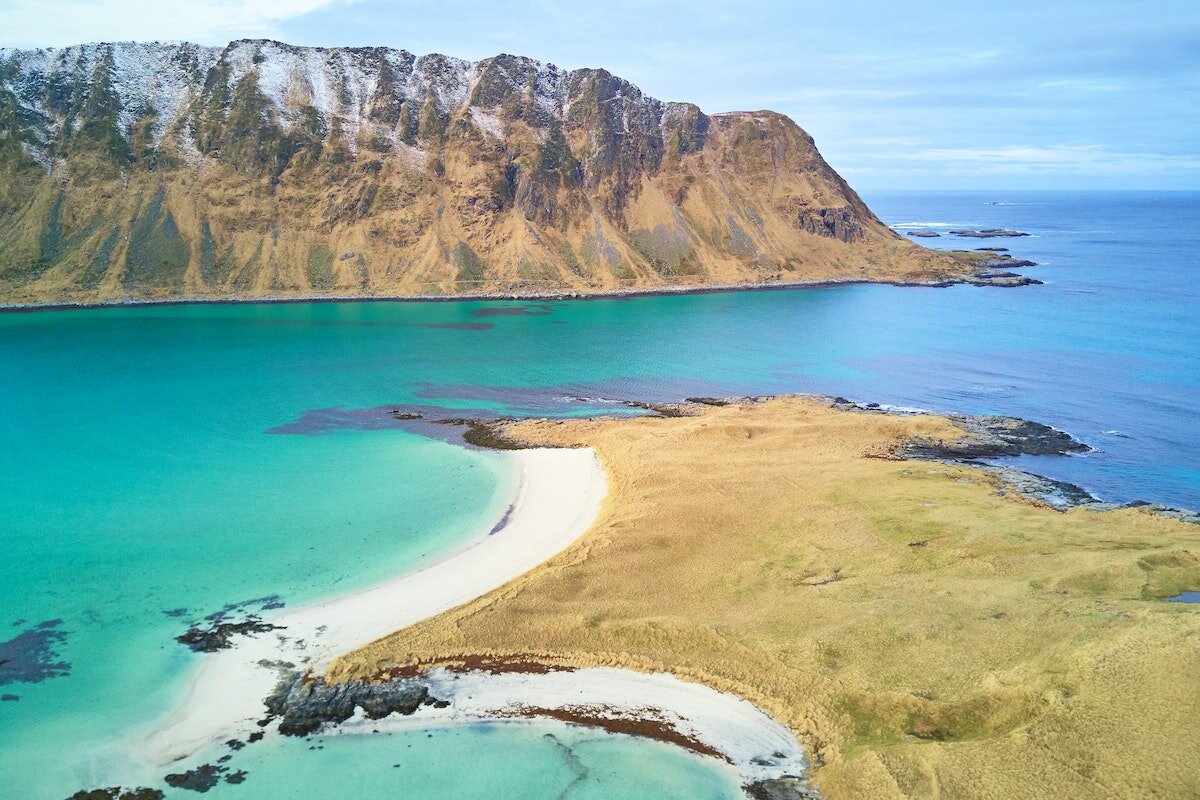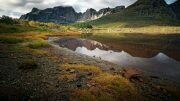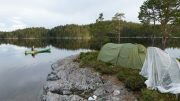Springtime is officially the start of the camping season in Norway. From what berries you can forage in the wild to where you are allowed to start a campfire to where is Norway’s most picturesque campsite, this is the ultimate guide to camping in Norway’s great outdoors.
When is the best time to go camping in Norway?
Now that Easter is behind us and the days will become longer and warmer (in theory, at least) many Norwegians start to dust off their camping equipment and head out into the woods or mountains to go camping. Nothing quite compares to that feeling after a hard day’s hike, walk, or trail of unpacking a tent, starting a campfire, and enjoying just how serene Norwegian nature and landscape are.
For those wanting to go camping in Norway, there is no “official” season yet – a rule of thumb – is that it starts after Easter (or at least when the weather is bearable outside, from mid-March onwards) and lasts (depending on where you want to camp) into September. Due to Norway’s temperate climate, however, the best months to camp are from late April until early September.
“Allemannsretten” and other basic camping rules
Unlike other countries, Norway has a long and proud tradition of the right to roam throughout the country. Dating back to ancient times, this right to roam (allemannsretten) has been enshrined in the Outdoor Recreation Act since 1957. This means that almost all of Norway is available to wander or walk through.
This right to roam is a key reason why camping is so popular in Norway. However, before you wander off into the forest, fjord, or amongst the fjells and pop a tent, there are a few rules to keep in mind.
– All tents and camping sites must be more than 150 meters away from any inhabited house, hytte, or dwelling.
– Aside from mountainous or remote regions of the country, if you want to camp in a place for more than 2 nights you need to ask for the permission of the landowner.
– Be considerate of others and nature. Always tidy up after yourselves and take all rubbish with you or dump it in a suitable trash can.
– When you answer the call of nature, in the wild, just remember to dig a hole and cover it with soil afterward.
– From April 15 to September 15, all campfires in and/or near forests are PROHIBITED. Campfires can be lit in places where the fire hazard is low – for example, by a lake, the ocean, or at an approved campfire site. Always check local weather conditions for fire bans.

What are some of the best family-friendly camping spots in Norway?
Every year, thousands of tourists flock to Norway to experience the sheer awesomeness and beauty of the natural landscape. Norway’s great outdoors can cater to every style, every budget, and every type of camping. Camping can be a great family holiday and for those that would like some communal facilities, these are some of the best camping sites in Norway :
Moskenes Camping – this camping area is situated high up in the balmy Lofoten archipelago. Renown for the Northern Lights, Midnight Sun, and some of the most stunning beaches this side of Hawaii, the camping area has communal toilets and a kitchen, and the site is situated right in front of the “Lofoten Wall” a series of breathtaking mountain peaks. Walking trails sprawl out from the camping site and there is plenty of fishing, hiking, and water activities nearby.
Preikestolen Camping – Why not camp near one of Norway’s most popular tourist attractions (and, most recently, backdrop for a DJ set!) – Preistekolen (Pulpit Rock). Due to high demand and popularity, this area is on a first-come, first-serve basis. It also involves a moderate hike from the nearest road, so come with your walking shoes on. However, it will be worth it when you camp with the backdrop of Lysefjord nearby.
Lovisenberg, Kragero – On Norway’s famous southern coast lies the town of Kragero. Situated on the coast with a myriad of stunning islands nearby, this quaint little town is as picture-perfect as it is charming. Lovisenberg Camping is a great family-oriented place with plentiful water activities to keep the kids busy and a beach within walking distance. The area is also famous as Norway’s favorite artist, Edvard Munch, painted many of his works here.
Lillesand – with Sørlandet’s capital, Kristiansand, just a small drive away, Lillesand is a beautiful summer town on the Skagerrak coast. The main camping area is just outside of the town and has a plethora of communal facilities. The town itself is worth a visit as it has a gorgeous array of those famous white Norwegian wooden houses and buildings. In summer, however, the town’s size swells with tourists from near and far. This town is especially popular for boating and water-based activities.
Wild camping anyone?
For those who want to experience Norwegian nature in all its glory, there is simply no better way than to go “wild camping.” This is a popular camping option whereby you, quite literally, pop your tent in the wild, away from civilization, and sleep under the stars.
Some of the best wild camping spots throughout Norway are only accessible by hiking off main roads and well-trodden paths. There is nothing better than getting out into nature to reenact your very own version of “Man (or Woman) vs. Wild.” However, before you head out to camp in Norway’s gorgeous nature, here is what you need to remember :
– Pack suitable clothes. There is an old Norwegian saying that “There isn’t bad weather, just bad clothes.” As such, even though it might be hot during the day, it is Norway and temperatures can drop at night time. Be sure to bring warm clothes even in the middle of summer. Don’t forget a rain jacket too!
– Location, Location, Location! Selecting the place you will pitch your tent is exceptionally important. There should be some tree cover (to protect you from the wind) and be sure to make sure you do not camp on a slope just in case it rains. Make sure you have selected a camping location well before it starts to get dark too.
– Get off the tourist paths. Some of the best camping spots involve, quite literally, hiking into the forest away from the well-trodden trails and paths. Part of the fun of wild camping is finding that perfect spot by chance, so don’t follow the crowd.
– Be close to some sort of water source. Whether it is a lake, a river, or the ocean, water is life. Nothing beats jumping in the lake after a long day’s hike. It is also important for cooking, hygiene, and replenishing your thirst. If you don’t plan to be near water or are unsure, make sure you pack plenty to drink.
Norway has 47 national parks and over 3,000 protected areas so the possibilities for wild camping are endless.
Nature’s snacks – foraging in the wild
One of the great features of Norway’s vast forests and fields is that nature provides an abundance of edible snacks. From field mushrooms to berries, hiking, camping, and walking can be made more delicious by foraging for some snacks.
Norway may not have an abundance of wildlife (sorry elks) but there is a plethora of edible mushrooms, flowers, berries, roots, and other goodies just waiting for you to pick them. Some of the most popular and plentiful edible treats include blueberries and chanterelle mushrooms.
For more information on what is edible and where check the Norwegian Association for Mycology and Foraging website here. This is a volunteer not-for-profit association that promotes the spread of knowledge about all things you can forage in the world.
Norway’s scenic wild awaits
The most important thing to be aware of in Norway, when camping, is to be respectful of the environment and nature. Remember that when you pitch your tent for a night or two, you are a tourist to that environment – there is a whole ecosystem that you are staying in. Norway’s nature is renowned worldwide for being pristine and unspoiled because governments, local authorities, and tourists have all worked hard to keep it so.
For more information on camping in Norway, check the Visit Norway website here.
Source: #Norway Today / #NorwayTodayTravel
Do you have a news tip for Norway Today? We want to hear it. Get in touch at [email protected]



Be the first to comment on "All you need to know about camping in Norway"